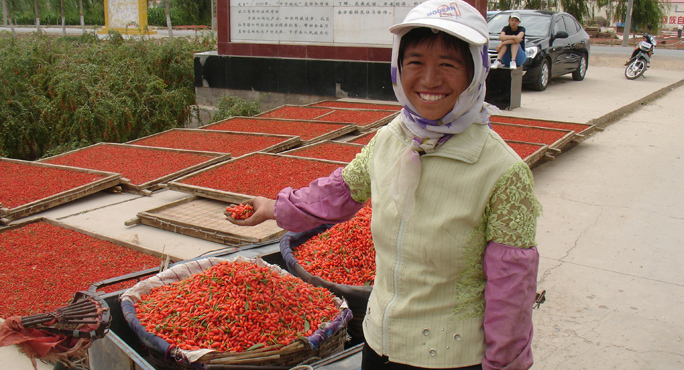Woman with Goji Berry, China. Photo by: Chris Kilham © 2009
A small red Chinese berry once obscure in other parts of the world has made its way into the US and European markets. That berry is goji. Also known as Chinese Wolfberry, goji is a nutritious snack and a widely used agent in traditional Chinese medicinal formulas for overall health and vitality, liver detoxification, and for improving eye health. The botanical name of goji is Lycium barbarum, and the bush from which this berry derives is cultivated on a very large scale in the Ningxia Autonomous Region of China, right up against the southern border of Mongolia.
In China, goji berries are eaten raw or dried, juiced, in wines, or cooked into herbal teas. The oblong reddish-orange fruits possess a light sweetness, and when dried they are the size of raisins. According to traditional use, goji berries are useful for enhancing the health of the liver, kidneys and lungs. They are consumed to improved immune function, boost blood circulation, and improve sperm production.
While the traditional claims have yet to be fully corroborated by medical studies, research shows that goji berries do impart health benefits. The compounds in the berries appear to help to normalize immune function, and the berries are unquestionably rich in protective antioxidants. Among these is zeaxanthin, an important antioxidant that plays a valuable role in eye health. Specifically, zeaxanthin may help with light perception, and it could also help to inhibit the development of macular degeneration, a primary cause of blindness. At the very least, goji berries provide nutrients of value to the eyes.
On the Goji Trail
Last year I had the opportunity to travel to China’s remote Ningxia region, to see the goji harvest. As a medicine hunter, I have witnessed the cultivation and harvesting of many plants around the world, but I have never observed such a colorful scene as that of the goji harvest.
Visit our Goji Berry Expedition Gallery
Ripe goji berries are oblong, plump and delicate. All harvesting is performed by hand, and must be accomplished with care, to avoid bursting the berries. Pickers pull the berries from the bushes on which they grow, and place them in baskets. Once a basket is filled, it is weighed and then the process starts all over again. As with many crops, people who harvest goji berries are paid by the amount they pick in a day. A good harvester can pick as much as 40 kilos of goji berries in a single day.
After picking, the berries are weighed, and then laid out on drying racks, or just on concrete. In the Ningxia Region, there are approximately 10,000 hectares of goji berries under cultivation at present. For purposes of comparison, a hectare is 10,000 square meters, equivalent to 2.41 acres. So there are over 24,000 acres of goji under cultivation in Ningxia. That is a lot of goji berry.
Over the past several years, marketers in the United States have seized upon goji berry as a miracle healing agent and a cure-all. On the web you will find excessive claims made for the miraculous healing powers of goji berry. This does the public an enormous disservice, and is wholly illegitimate. Goji berries are good food, for sure. They do possess beneficial compounds, and they may in fact be especially helpful for maintaining eye health. They are also delicious. But to promote them as possessing broader curative properties is deceptive.
Today in supermarkets and natural food stores you can find dried goji berries in bags as snacks, mixed into various types of trail mix, in some types of granola, and even in various energy bars. This is the way to consume goji. Avoid the absurdly expensive, highly diluted “juices” of goji sold by network marketing companies, who will charge you $40 dollars for what should cost a dollar and a half. And forget the testimonials that assure “My Aunt Minnie drank goji and returned from the dead.” That never happened.
People travel the world, art and music travel the world, languages travel the world, and so do foods. Goji berry, once only consumed in parts of Asia, has traveled to the United States, and now is available in most food stores. Possessing beneficial antioxidants and a delightful sweet flavor, goji berries just might make it onto your list of favorite, healthful snacks.


